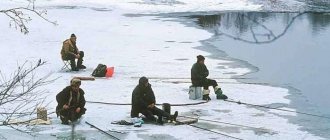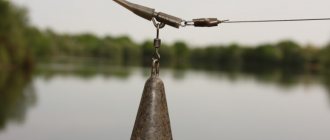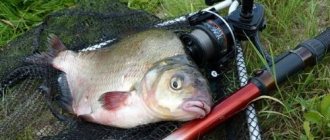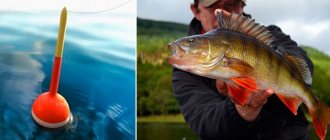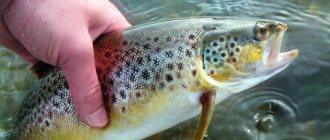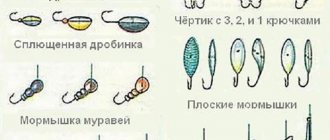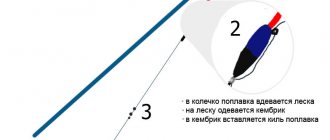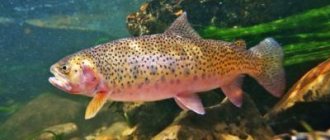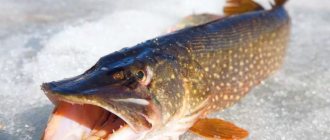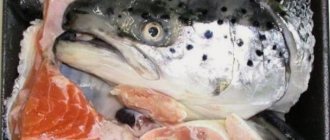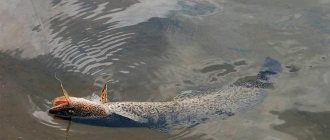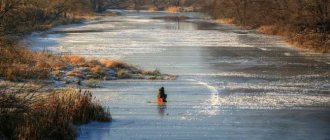I became acquainted with trout and the local Fishing Festival at Shawinigan River. There I learned how to troll trout during the summer months. But here's to getting to holiday directly in Montreal I only succeeded this year. There I looked at various equipment options for fishing Quebec trout.
about spinners for trout fishing , which you can buy here. Small spoons, spinners, small wobblers - over several years they were tested on the Shawinigan River and showed good results there.
But there is a current on the river, but in places where trout are caught during the Fishing Festival, there is usually no current, so the variety of equipment used is much wider. Below I will describe various trout fishing options that can be used both during the holidays in Montreal and on other bodies of water in Quebec.
1. Bottom equipment for standing water.
The main line passes through a sliding sinker (olive, bullet, drop, cylindrical), then through a small bead and tied to a swivel or snap hook. The bead prevents the knot from being broken by the weight when casting. In extreme cases, you can do without a bead, because the weights are used with small weights.
A leash from 15 to 30 cm with one small hook is tied to a swivel or carabiner. Hooks with a long shank are more convenient for attaching worms, while those with a short shank are more convenient for artificial eggs and corn.
This is the simplest equipment for standing water (ponds, lakes). Small weights are used, from 14 to 28 grams, since rods and lines for trout fishing weighing 200-450 grams are used with small weights. If there are branches, algae, a scattering of stones at the bottom of the reservoir, then the bullet, like a weight, passes through it all better.
The usual bait is earthworms. You can also plant artificial salmon eggs (1-2 eggs each) and canned corn (2-3 corn eggs each). For donkey, artificial eggs should not be too soft, as the trout will quickly tear them off. Bright orange eggs work well. Worms are traditionally an excellent bait; trout actively swallow them and can fiddle with the bait for a long time without throwing it.
2. Bottom equipment for current.
If you use sliding drop weights or weights with a cylindrical shape in the current, they will roll along the bottom. Therefore, dead hooks on branches and stones are inevitable, which means that the gear will break. To avoid this, it is best to use flattened sliding weights or make equipment according to the patternoster principle. Otherwise, the baits and leaders are the same as for bottom equipment for calm water.
3. Bottom equipment for floating baits.
The weights here are the same as in the rigs described above. Here, only a longer leash is used, from 30 to 90 cm. The paste that is sold in stores is floating, it is not very suitable for float fishing, since the hook with the paste floats above the weights and the level of the bait in the water layer is difficult to control.
For floating paste, from which a ball is simply molded, it is best to use a tee rather than a single hook. The paste will stick better, more evenly, and when a fish bites, the chance of catching it is higher. If you use floating eggs, you can plant them one, two, or three on a tee.
If it is necessary to make floating worms, then air is pumped into the worms already attached to the hook with a small syringe with a needle. This causes the worms to hang in the water column rather than being located at the bottom of the reservoir.
4. Equipment for active wiring.
This equipment is used both in still water and in currents. A hook is attached to the main line. Several clamping weights-pellets are fixed 30-40 cm from the hook. The tackle is cast, a short pause is made so that the sinkers and the bait sink to the bottom, then they are dragged in by making a couple of turns with the reel.
Very similar to the stepped retrieve when fishing with a jig. If there is a strong current in the fishing area, the tackle will “hang” in the water column. In small currents or in still water, the pellet weights will be the first to fall to the bottom, and then the bait (corns, worms, silicone) will slowly fall to the bottom. It is at this moment that the trout most often takes it.
5. Oscillating spoon with a leash.
This is a traditional rig for Quebec and is used to catch both rivers and lakes. To do this, take different oscillating spoons (5-10 cm), tie a 30-cm leash with one small hook instead of tees. Worms (live or silicone) and artificial salmon eggs are used as baits.
The spoon itself is used, firstly, as a sinker - to throw the bait, and secondly, as an attracting element - the fish pays attention to the play of the spoon, but attacks the bait.
You can cast the bait with the current and let the line out a little, so the bait goes ahead of the spoon. Or, after casting, you can pause until the bait is carried away by the current or falls to the bottom.
When pulling a spoon towards you in a lake or on a calm current, the spoon goes first, and the bait comes behind, so that the trout catches up with the bait and attacks.
6. Float equipment.
In general, I haven't seen many local fishermen fishing with float rigs. But at the Fishing Festival in ponds and lakes, float gear is often used. Fish released into the water move in schools along the shore, so there are quite a lot of chances to catch trout on a float.
Since they catch small trout at the Fishing Festival, they use ordinary spinning rods; rarely anyone uses special gear.
They use various floats, whatever they can do (weighing from 2 to 10 grams) - the heavier the equipment, the further from the shore you can throw the tackle. Sinkers are used, again, by anyone - either one through sinker, or a chain of small pellet weights. Below the weights there is usually a small swivel, to which a leash a little thinner than the main line is attached. While you can use a fishing line of 10lb or more on the bottom without any problems, it is difficult to throw floats with such a fishing line. It is best to use 8lb or 6lb monofilament, and for the leader take a line 2lb less than the main line.
To catch trout using float rigs, earthworms, artificial salmon eggs and other sinking artificial baits are again used. As I wrote above, you can fish with paste, but it hangs in the water column and can rise above the sinker, so the bite will not be immediately visible and you cannot accurately determine the depth of the paste.
7. Fishing with a float.
In small rivers and streams they often fish using a fishing line with a float, i.e. let the rig go with the flow, sometimes holding the float. In this way, you can fish promising sections of the river. Since wild trout are caught in this way, and not bred ones, the size of the trout can reach sizes of more than a kilogram. An artificial egg or plastic bead, located a few centimeters above the bare hook, is used as a bait.
Live earthworms are well suited for float fishing and for donkey fishing. For active fishing (spoon with a leash, equipment for active retrieving), it is better to use artificial bait.
Local stores have a fairly wide selection of different lures for trout fishing. For myself, I chose several different types: artificial salmon eggs, floating paste and “marshmallows,” silicone worms and larvae.
Artificial salmon eggs are very soft and quite elastic. Soft eggs emit a lot of attractant (special flavors to attract fish), but they tear very easily when bitten, so they are practically disposable. I put it on the hook and after the bite there was nothing left.
More elastic eggs stay on the hook better; after catching a fish, the eggs remain on the hook, even if they are “bruised”. Well suited not only for a float, but also for vibrators with a leash, for active retrieving, and for donkeys.
Silicone worms have proven themselves well on spoons with a leash, on small jig heads, and on float rigs when fishing in currents. I had good fish in both classic red and bright pink.
It is best to plant several larvae . They are bright and emit an attractant. They stay on the hook well. In addition to trout, you can also catch perch and other small fish on them. Suitable for float fishing and lure fishing with a leash.
They can be mounted as a chain, i.e. like an earthworm with a “stocking”, or you can, like a bunch of maggots, thread several pieces with a hook through the thin part of the larva.
The floating paste should be rolled into a ball and placed on a hook, or better yet, on a tee. A long leash on the donkey allows you to adjust the height at which the bait hangs at the fish feeding level. If the hook is heavy enough, then it is worth making a larger ball in order to “lift” the bait from the bottom of the reservoir. The same applies to the marshmallow . This is a soft bait, like a marshmallow, that gets wet quite easily and falls off the hook in the current. Therefore, floating baits are best used on lakes and ponds.
How to properly attach an artificial salmon egg to a hook
Artificial salmon eggs, especially dense ones, stick well to the hook. There are several ways to attach eggs, one at a time, two at a time, or even three at a time.
Here is the easiest way to attach eggs so that they do not fly off the hook when casting.
You can also leave the point of the hook open, if you take a larger hook, you can add other elements to the egg, you can even use a tee.
It is best to pierce delicate eggs with thin hooks; thick ones can tear them. Well, the sting of the hooks should be sharp enough so that the eggs are pierced and not burst.
Summary: The above is quite enough for trout fishing at the Fishing Festival in Montreal and the surrounding area. You can find useful and interesting information about fishing for wild trout here - “Trout fishing in rivers and streams. Practical guide from DZ."
Source: rybalkavmonreale.ru
Fishing methods
Depending on the characteristics of the reservoir in which the trout lives, you should choose a fishing rod and bait. You can fish successfully with both artificial and natural baits.
Spinning fishing
Many anglers, when choosing trout gear, take into account the predatory tendencies of the fish. Spinning is a universal tackle that allows you to fish both on paid ponds and on small rivers. But there are serious differences in fishing techniques. If you can use light baits in still waters, then in the current you have to make the equipment heavier. The choice of wiring depends on the fishing location and the type of bait. To animate rotating spinners, uniform wiring is used, and the use of a wobbler requires the angler to be able to make a jerking retrieve. Sometimes good results are achieved by stepwise wiring of twisters or vibrating tails.
Bombard
When it is impossible to cast light artificial baits long distance with a spinning rod, effective trout fishing is carried out using a bombard (sbirulino). A distinctive feature of the gear is a special float. Its task is to make the equipment heavy. Thanks to this design, it is possible to throw the smallest spinners and wobblers far. For clear water, plastic water-fillable models are best. In addition to spinners and wobblers, you can fish with bombarda with natural bait.
Donka
Traditional gear that has been used on rivers for a long time includes donka. This fishing rod allows you to make long casts of edible baits. To prevent the current from carrying the equipment away from the selected point, the fishing rod is equipped with a heavy sinker. The best time to fish with a donkey is after heavy rain, due to which the water becomes cloudy. Often the gear is set at night, and in the morning fishermen remove the prey from the hook.
Feeder
Feeder trout fishing has several significant differences from classic fishing. When equipping a feeder, it is necessary to take into account that trout feed in the water column. Therefore, the bait should hover in a certain horizon, and not lie on the bottom. An advantage of the English donkey is the presence of a feeder. Thanks to bait, it is possible to gather a large flock at the fishing point.
Surface fishing
With the arrival of summer, the pestle rises to the upper layers of the water, where it catches fallen insects. This is the best time for fly fishing. The tackle allows you to use imitations of insects, realistically floating the bait downstream.
You can fish from the surface using a float rod. In this case, natural baits are used.
Catching the line
Trout instantly reacts to food objects passing by. This feature of the fish is used by lovers of float fishing with retrieval. Very interesting places for such fishing are rifts, whirlpools, and the boundaries of direct and reverse currents. Previously, the main bait for such fishing was a worm, but today paste shows good results.
Donka
Traditional gear that has been used on rivers for a long time includes donka. This fishing rod allows you to make long casts of edible baits. To prevent the current from carrying the equipment away from the selected point, the fishing rod is equipped with a heavy sinker. The best time to fish with a donkey is after heavy rain, due to which the water becomes cloudy. Often the gear is set at night, and in the morning fishermen remove the prey from the hook.
Fishing rod equipment
Trout fishing also leaves its mark on the set of gear. There are certain adjustments that need to be made to each rod.
Spinning
To hunt for trout with a spinning rod, you need to make a light but durable fishing rod. The gear has some differences when fishing on a river or in a pond.
- The length of a fishing rod for river fishing is limited to 2.4 m. Usually it is an ultra-light spinning rod with a casting weight of up to 10 g. It is more convenient to make long casts in ponds with a fishing rod of 2.7-3.0 m. These are light or medium-class models with a casting weight of up to 20 g.
- The tackle is equipped with a spinning reel 1000-2000.
Before fishing, it is important to accurately adjust the friction brake. After the bite, the trout makes sharp jerks that can break the fishing line.
Source: fishelovka.com
Float tackle for trout fishing
Trout are caught using float tackle because of its ease of use. The fisherman does not require additional knowledge and skills, as when fishing with any animation.
The equipment of the tackle depends on the fishing area: for river or lake trout. The differences are in the flow, which requires additional structures.
Rod
- The rod does not require additional characteristics - it is standard, as when fishing for crucian carp.
- The main selection criterion is lightness, since capricious trout require a large number of casts and movement along the shore. This quickly gets your hands tired.
fishing line
- The fishing line should not be thicker than 0.25 mm for the largest fish, and not less than 0.2 mm if the fish is small.
- The optimal hook would be number 6-8.
- A leash 18-20 cm long and a reel with about 50 m of fishing line will also not hurt. This option is optimal so that the fish does not fall off when fishing.
Fishing Features
One of the most prominent representatives of salmon fish is rightly called brook or lake trout. Catching a trophy specimen is quite difficult; only true professionals can cope with such a task. Despite this, trout is the desired catch of every fisherman, so many of them go to paid reservoirs to catch a large fish with their own hands. This excitement is caused by the difficulty of catching and the incredibly tasty meat of this fish.
To catch trout, you need to know what places it prefers and where it hides during spawning. A large number of fish can be found:
- in fresh reservoirs with clean and cool water;
- in mountain lakes with cold, crystal clear water;
- in paid trout reservoirs;
- at depth in shady places where direct sunlight does not penetrate.
Finding a fishing spot is only 40% of successful fishing. The correct equipment, bait, and technique play a big role in such a complex matter. Despite the fact that experienced fishermen use spinning rods equipped with artificial bait to catch trout, trout paste is becoming increasingly popular among them. It is strung on the hook of a bottom or float rod and attracts fish with its bright color and strong aroma. A special mass can be purchased at a fishing store or made with your own hands.
Where and when to fish
Trout lives in fresh water and loves clean and very cold rivers. Most often it lives in mountain lakes. There are two types of predator: lake and stream. The fish is highly attentive and cautious, which is why it is quite difficult to catch. There are paid reservoirs for catching trout. At the same time, there are places where it is bred.
At the end of winter, when the ice melts, trout become active.
This fish loves rivers with large currents. This is because in the daytime, when trout are not hunting, they go to the bottom, stand against the current, and begin to catch fry swimming with the flow. She prefers rocky bottoms.
Where to catch trout
We looked at fishermen's reports and marked on the map where trout were found.
Which equipment to choose
Equipment for trout fishing with paste can be very diverse, thanks to which many anglers can abandon expensive spinning rods, preferring a float rod, feeder or bombard. Despite this, any tackle must meet certain criteria. You need to be able to choose the right fishing line, hooks, reel, adjust the leash, etc.
Float rod
This type of tackle belongs to budget type fishing rods; there are no special requirements for it. But in order for lake or brook trout fishing to be successful, it is recommended to adhere to the following criteria when equipping a float rod:
- length of the form - not less than 3 and not more than 4 meters;
- line diameter - 0.2 mm;
- thread length - 50−100 meters;
- a leash 0.18 mm thick, which is attached to the end of the fishing line, its length should be about 50-60 cm;
- hooks numbered 10-14, depending on how large a trophy you want to get.
A float and a reel of any type are suitable for equipment . But it is advisable to use a floating type of paste .
Bottom tackle
This rod is especially popular among fishermen, because it allows you to fish in areas of the reservoir remote from the shore. Another advantage of bottom tackle is the opportunity to catch large fish that prefer to lie at the bottom of a lake or river. Modern donks are equipped with a feeder rod, which simplifies the fishing process. Equipment for trout fishing on a feeder should be as follows:
- rod length - from 2.5 to 3.3 meters;
- inertia-free coil;
- quick-release weight;
- fishing line, the thickness of which varies between 0.15−0.25 mm;
- a leash made of thread 0.2 mm thick and about a meter long;
- hooks from No. 8 to No. 12, depending on the size of the intended prey.
This fishing method involves the use of sinking type paste. For successful fishing, it is better to use nylon lines.
Bombard with float and sinker
An unusual rig that is rarely used by fishermen, but can be indispensable when it comes to trout fishing. To create it, a sinker and a float are used. It is best to use a weight made of brass or lead, this will allow you to throw the tackle as far as possible. The bombard itself should be transparent or translucent so that the fish cannot notice it in the water column.
The fishing technique is as unusual as the equipment itself. After a long cast you need to make a slow retrieve. While retrieving the fishing line, you should take short pauses so as not to spook the wary trout.
A little play with bait will be a big plus while fishing and will help increase the number of successful bites. The best bait for bombarda is floating paste.
Fishing Features
On paysites
Today there are a large number of reservoirs in which trout are bred artificially.
Many fishermen prefer paid fishing because it has the following positive aspects and features:
- In such reservoirs, there is guaranteed to be prey , since employees of fishing bases always maintain the population size and are ready to give all recommendations for obtaining a rich catch.
- In fact, in all paid reservoirs, rainbow trout is artificially bred - this is a breed brought from America and prefers to live in cool waters. Taking this feature into account, it is necessary to search for it at great depths, using suitable bait.
- Before going to a paid reservoir, it is best to find out the conditions of the banks, as well as the possibility of fishing from boats. This will allow you to select a suitable spinning rod in advance, since the length of the rod will depend on the fishing conditions.
In fact, rainbow trout is artificially bred in all paid reservoirs - this is a breed brought from America and prefers to live in cool waters
Fishing seasons
The behavior of trout can change in different seasons; without taking this feature into account, it is impossible to get an impressive catch.
The specifics of fishing depending on the specific season are discussed below:
- Trout fishing is popular all year round, but in winter only the most experienced anglers decide to try it. This is due not only to worsening weather and temperature conditions, but also to the passive behavior of prey. Winter fishing is carried out from ice; mainly a special type of spinner is used as bait, but jigs, balancers or trout paste can also show a high degree of efficiency. This breed goes to the same parts of the reservoir for the winter every year, so it’s enough to simply detect them and return to these places every winter, selecting the most catchy bait.
- At the beginning of spring, the specifics of trout fishing differ little from winter fishing, since the prey continues to remain in the pits and shelters in which the winter took place. Gradually, the water warms up, and the fish begins to more actively explore the reservoir in search of food, its appetite begins to awaken, which leads to an increase in the number of bites. The melting of ice and snow leads to a rise in the water level and its cloudiness; fishing during this period is the most difficult, since in such conditions it is extremely difficult to find trout risers.
- In summer, fishing in hard-to-reach places, for example, near underwater snags, is considered the most promising. To study them, it is best to use small wobblers, which must be equipped with powerful and well-sharpened tees, since due to difficult fishing conditions it is necessary to immediately hook the detected fish. Another common bait that is used in the summer are spinners. The main requirement for any bait is an active and interesting game, since at this time the reservoirs are teeming with food, and you need to try to attract the attention of trout.
- The autumn period is considered the most successful for trout fishing, since it ceases to be so shy and is characterized by quite active behavior, which leads to a good and stable bite. This is due to the approach of winter, so the fish begins to eat more, increasing fat deposits. In autumn, it is recommended to use natural baits, for example, maggots or bloodworms, although various spinners and wobblers can also bring a rich catch.
Types of pasta
Adult trout feed on small fish, frogs, insects, larvae and crustaceans. Despite this, fish are willingly attracted to bright trout paste. It contains various aromatic additives that attract adults. And the bright color of the bait irritates the trout and makes them want to swallow it.
The paste is sold in small jars. It can easily be purchased at a fishing store. On paid reservoirs it is issued if the fisherman rents gear. There are only two types of bright bait:
- Sinking paste, it is quite dense, so it quickly sinks to the bottom to attract large fish. The colorful, elastic mass is perfect for fishing with bottom tackle and performing quick retrieves.
- A floating paste that floats in the water column for a long time, after which it slowly reaches the bottom, if it does not become prey for trout before this moment. It is used when fishing with a float rod to catch specimens located on the middle horizon or on the surface of the water.
Although trout paste is inexpensive, it is not necessary to buy both types. To make the floating type heavier, just add a piece of sinker or a small lead ball, after which the bait will sink to the bottom. The sinking type bait can be made lighter by mixing it with foam balls.
Regardless of the type of paste, it contains the same components - a concentrated protein mixture, natural or artificial flavors, and dyes. The result is a mass with a pungent odor. To catch trout, it is better to choose a paste with a garlic, cheese, fish or caviar flavor. The color of the bait should be bright, it is good if the mixture is supplemented with sparkles.
DIY bait
Experienced fishermen know that it is not necessary to buy pasta in the store; you can make it yourself. The cheese mixture showed excellent results while fishing for trout. Composition of trout paste with your own hands:
- You need to take 2 raw chicken eggs, break them and pour them into a bowl. Add a little milk to the egg mixture and beat the ingredients thoroughly to obtain a homogeneous mixture, as for an omelette.
- The finished mass is poured into a dry frying pan. The products must be constantly stirred and fried until all the liquid has evaporated.
- Trout feed is added to the egg-milk mixture, which can be purchased at any pet store. An appropriate addition would be cyclops and daphnia (1-2 glasses, depending on how much of the finished product is needed for fishing). These components are ground into flour and also added to the omelet.
- The main ingredient in homemade pasta will be cheese with a strong smell. It is grated on a fine grater and added to the mass. Chopped fresh herring or sprat is another indispensable component of cheese bait.
- At the very end, you need to add canned corn in the form of puree (you can grind the product with a blender or through a meat grinder). To ensure that the mixture is well mixed, corn juice from a can is added to it.
All components are thoroughly mixed. The cheese spread for trout fishing with your own hands is ready, you can go fishing.
Putting pasta on a hook
Using trout paste is quite simple and convenient. After a few trainings, setting the bait will take no more than a minute, and your skills will improve. The entire process of stringing pasta onto a hook can be divided into several stages:
- First you need to pinch off a small piece of the mixture, roll it out on your palm and form a small ball in the shape of a pea.
- Next, you need to immerse the hook in the paste so that it is not noticeable. If any part of the hook remains uncovered, the fish may get scared. You need to attach the bait firmly so that it does not disintegrate in the water.
- After this, you need to give the bait a round or oval shape.
In the store you can buy a special paste mold that can turn an ordinary pea into a fry, mussel, larva or bug. This bait will look more believable and realistic, which will help attract the attention of trout.
Features of fishing
When fishing for trout with paste, equipment plays an important role, but the time of year and weather conditions are equally important. In summer, the fish lies on the bottom, because it prefers cool places. In winter, adults are especially picky about food, their sense of self-preservation is heightened, so any careless movement can scare off the prey. For fishing to be successful, you should know in advance what bait, tackle, and fishing technique to use:
- In winter, it is better to use bait with a strong aroma and attractive appearance. A paste with glitter and garlic flavor is suitable for this. If fishing is done from ice, then you should make several holes at once and fish them one by one. You can explore both the bottom and the upper layers of water, because the fish constantly wanders in search of food. If you bite or catch a trout in one of the holes, it is better to immediately move on to the next hole.
- In early spring, the trout bite is at its peak. Catching a trophy specimen becomes easier if you follow certain spring fishing conditions. For fishing, it is better to choose places with rifts and gentle currents. At this time, the fish prefers to eat animal food. A pasta with a fishy or shrimp flavor would be an excellent choice. When fishing, use a slow, steady retrieve and floating bait.
- In summer, trout activity decreases. Catching her is quite difficult, but possible. To do this, in the summer it is better to use a bombard or donka, because the fish lies on the bottom in search of a cool place. You should look for trout at depth, in the shade, near underwater vegetation or trees. Sinking paste is used as bait, and the best time for fishing is early in the morning or evening.
- Autumn is the most favorable time of year for catching lake and river trout. In the autumn, this representative of the salmon family goes to spawn, so it leads an active lifestyle. You can catch a trophy specimen anywhere in a body of water. Any bait and tackle is suitable for fishing. In autumn, fisherman should not go into the water so as not to damage the eggs. On cold days there is almost no bite; it is better to go fishing when it gets warmer.
Regardless of the time of year, it is enough to follow these rules of seasonal fishing, and a large catch of trout for pasta will not take long to arrive.
Trout fishing with paste equipment
A ball with a diameter of 10 millimeters is made from the paste. The ball is placed on the hook. Hide the point of the hook inside the paste so that the fish does not notice it. Fix the paste on the hook with your fingers so that it does not slip off during the current. You can throw bait into the water. Use a mold to shape the paste as desired. Predators are caught on them more often. These molds are sold in fishing stores.
How to use trout paste
The use of the paste depends on the time of year. It is difficult to use in winter. This takes practice. In winter, trout are picky about their food choices. She becomes cautious and reacts to any noise. Therefore, pay attention to the following:
- In winter, you should rely on baits that have a very strong smell. But the smell should not be strong, so as not to scare away the fish. You should add glitter to the bait, this will attract additional attention.
- Finding trout habitat becomes a big difficulty. The fish does not stand in one place, but constantly moves in search of food. However, it can live only at the bottom or only on the surface of the water.
- If you catch a fish in one hole, move on to the next, as there can only be one fish in one hole.
- If your area has warm winters, use the paste as you would at other times of the year.
The paste should not be frozen so that it does not lose its properties.
The secret of catchy pasta
Trout paste consists of proteins with added flavors. The following flavors work well:
- Garlic.
- Cheese.
- Fish.
- Caviar.
The primaka is cooked depending on whether you want it to touch the bottom or not. Experienced anglers choose the second option, since trout prefer the middle and upper layers of water. If you are fishing in holes, you will need sinking paste. But there is no need to prepare both options. Prepare a sinking paste and attach a piece of foam to the bait. This way she won't drown. If you need the paste to sink, increase the amount of weight.
Shine is added to the store-bought paste, which provokes the fish even more. Of the colors, trout respond better to yellow and orange.
Putting pasta on a hook
It is considered difficult to place pasta on a hook. But that's not true. You will need:
- Take a small piece of food.
- Make a ball the size of a corn kernel.
- Place the paste on the hook so that the point and shank are hidden.
- Seal the paste with your fingers so that it does not wash off in the water.
Do not store pasta in the freezer. It loses its smell and beneficial properties.
Don't skimp on pasta. Trout can eat more than half their body weight.
Some useful tips
Many fishermen claim that fishing with pasta is completely ineffective . In fact, a negative result is a consequence of improper use of trout paste. Here are a few mistakes that anglers make when going to a body of water with paste bait:
- Improper storage of the product. Due to the fact that the paste often contains natural ingredients, it can easily deteriorate or lose its properties. In order for the bait to retain its unique aroma and attractiveness, it should not be stored in the freezer or in a place with sub-zero temperatures.
- Product savings. If you want to get a decent catch, you should never be greedy. Hungry trout are constantly searching for food in order to stock up on enough nutrients. The larger the volume of the bait, the better and more successful the bite will be.
- Incorrect installation. When in contact with water, the paste may fall apart, especially if fishing is carried out on a river with a strong current or on riffles. Before throwing the bait into the water, it should be thoroughly compacted with your fingers.
These little tricks will help you quickly catch the long-awaited trophy. Proper use of the paste will immediately dispel all rumors about the ineffectiveness of this amazing bait.
The use of trout paste does not require a lot of experience, skills and knowledge from the fisherman. Thanks to the attractive, fragrant, bright bait, even a beginner will be able to catch such a cautious fish. You just need to choose the right gear and use the right fishing technique.
Source: ribalka.guru
Where to fish for trout
Under natural conditions, river trout fishing is organized on fast, cold streams with depths of no more than 1-1.5 meters. As a rule, the bottom bases of rivers suitable for fish habitat are hard rocky or pebble areas of different levels. Riffles, rapids, and rapids of a stream with areas of relatively calm water are always feeding grounds for this type of salmon fish. Under natural conditions, individuals rarely stay in places with aquatic vegetation, preferring open areas of water areas, where it is better for them to navigate, looking for food in the form of insects that have fallen into the water stream and small helpless fish drawn into the rapid current of the river.
Fishing for trout on a platform is radically different from the conditions of the natural environment. Artificial ponds are mostly stagnant bodies of water with depths of up to three meters and clayey bottoms, surrounded by various vegetation. The boundaries of the depth difference and the squiggles of individual sections of the pond make these places a stopover for fish and their hunting grounds. Trees hanging over the water, shading the water surface, always attract trout due to colder water and the presence of a significant amount of food objects falling into the water from leaves and branches, becoming easy prey for fish. The walls of the coastal reed thickets do not go unnoticed, where the predator plies in search of small things, combing trajectories that follow the contours of the coastline.
When to catch trout
Fish activity varies significantly depending on changes in water temperature. And if it is more common for fishermen to expect an increase in biting activity for other types of fish with warming water areas, then in this case it is best to catch trout when the water bodies are not warmed up or begin to cool down. The most favorable period for hunting is considered to be autumn, when the temperature of the reservoir drops significantly, and the fish begin to intensively gain fat for the spawning period and winter.
From the first ten days of October until freeze-up, the most significant surge in bite is observed. Fishing is carried out using float, spinning and bottom gear. Winter is a relatively weak season for fishing. The fish does not feed during the mating season, and after it saves energy by hiding in the recesses of the bottom, only occasionally picking up passing food nearby. But knowing the anchorage points of a school of fish, fish can be successfully caught from the ice and taken for bets. With the appearance of melt water and the disappearance of ice, spring activates the predator for increased feeding and until the water temperature stabilizes at levels above 15 degrees, the fish bite greedily and with equal constancy. In muddy water they fish with spinning rods and float rigs. In summer, fish are caught near cool springs and shady shores of the reservoir. The bite is unstable, improving only when it gets colder.
Important! Characterizing the intensity of the bite according to the daily cycle, it is worth noting that in any period of the year, early morning and evening twilight stand out most from the rest of the time in terms of frequent attacks by the predator.
During the day, the bite is active only in late autumn and on some winter days, with a slight thaw. Cloudy weather with light drizzle is ideal for fishing. The sun always negatively affects the activity of cautious and timid fish.
Spinner for trout fishing
There are both rotating and oscillating types. Taking into account the characteristics of trout habitat, mainly in water areas with running water, spinners with a sufficient petal thickness in terms of density are recommended. For example, Finnish spinners are designed for catching salmon, so the thickness of their blade is significantly different from the usual one. The peculiarity of the dimensions of the petal, even in a fast current, is its constant rotation without much vibration and maintaining the immobility of the bait. Spoons No. 1, 2 are best suited, and in the fall and in dirty water conditions, No. 3, 4 will be effective. In the hottest summer period, it is advisable to use No. 0, 00 or the smallest models of our own production.
For trout fishing in deep water, spoons with a weight-head give good results. A variety of jig baits, such as twisters, rippers, and fish made from foam rubber, will be very useful. Based on the accumulated experience, we can say with confidence that a jig spinner with a leash when fishing for trout gives positive results. The advantage of such a bait is the efficiency of its operation in different phases of the retrieve. A metal leash protects the spoon from getting caught, and the tee should be secured with a cambric. Successfully selected weight of the head in relation to the fishing characteristics makes it possible to use any type of wiring.
To increase the efficiency of the spinner, it will be enough to hang a silicone twister or fly on it, in particular large fluffy white flies. Oscillating spoons of the smallest sizes are considered less popular for trout fishing. In rare cases they show quite good results. There are periods when the fish are attracted to all baits indiscriminately, and on some days they like the spoons. In this regard, you should also have oscillating spoons in your arsenal, which need to be checked from time to time.
Lures for fishing
The nutritional interests of salmon fish species vary in their preferences depending on the season of the year. During periods of mass emergence of insects from spring to the first half of autumn, the fish actively feeds on any type of mayfly. The rest of the time, the predator hunts for small fish and waterfowl, and also collects plankton of various compositions from freshwater crustaceans and larvae of various insects at the bottom.
On platoons, trout are accustomed to eating food of plant origin based on fish feed and flour ingredients, and in particular, ordinary white and black bread. Like natural food of animal origin, due to the aggressive nature of the predator, it is caught using various imitations of natural food objects, equipping them with hooks. Next, we will take a closer look at baits for catching this type of fish, dividing it into natural and artificial baits.
Natural baits
Natural baits include leaf and dung worms, using them in baits mixed with maggots, verkhovka fry, gudgeon, bleak. To inert baits, due to the high success of their use, you can safely add fillets of various types of fish, the pulp of toothless clams and pearl barley, crumbs of white and black bread, as well as flavored dough, which was transformed by modernizing the composition and improving the balance of ingredients into a specialized bait, the so-called trout paste.
Artificial baits
Spinning rods for trout fishing are equipped with wobblers such as minnow and crank, rarely exceeding five centimeters in size. It is preferable to select a minnow with its own game, which makes the animation of the bait on a regular uniform reeling. Rotating spinners with petals in the form of a drop and a willow leaf, with striped colors or with distinct red or blue dots scattered over the area of the working body are also enjoying significant success. Artificial flies and beetles with non-wetting hair feathers attract predators no less than dense and voluminous baits.
Lures
Trout are not particularly picky eaters and react to almost any bait.
The choice of catchable bait depends on factors:
- Seasonality.
- Weather.
- Water temperature.
- Predator mood.
We recommend reading: Winter fishing for carp: choosing gear and fishing tricks
Among the most catchy trout baits are:
- Wobblers.
- Microoscillators.
- Silicone baits.
- Turntables.
Popular artificial baits
A wide range of artificial baits provides the opportunity for experimentation.
Rotating designs of spinners work well, especially in size No. 3. They have active play at different depths and powerful vibration, which attracts active fish from a long distance, even in noisy riffles.
As for the color. It depends on the specific body of water. The classic use is:
- Gray baits.
- Spotted.
- Silvery ones.
- Golden.
A bright red color works very well for trout. The bait can be painted either partially or completely in this color.
Wobblers, including sinking structures, with a body length of 40-100 mm, do not lag behind spinners in terms of catchability. Their natural play provokes the predator to attack.
When the fish is passive, small spoons and castmasters can come to the rescue. They often arouse interest in this bait even among well-fed trout.
Using natural baits
This type includes:
- Earthworms.
- Larvae: maggots, bloodworms or their simultaneous use.
- Insects: flies, bees, grasshoppers and beetles.
In spinning fishing, these compact baits can be used with spaced rigs. Although the method is not sporting, natural baits are guaranteed to help you get away from zero if the bite is sluggish.
Trout bite well on live bait or small pieces of fresh fish. You can use bleak and gudgeon as live bait, which is effective in the fall.
Choosing a trout spinning rod
Spinning rods for trout differ in their technical characteristics depending on the type of reservoir in which fishing is carried out. The natural conditions of a reservoir with rapid currents require more stringent conditions for the parameters of gear, in contrast to comfortable fishing on paid ponds with stagnant water. Let's consider the main approaches to choosing gear based on these differences in the structure of the reservoir.
Length selection
In a pay zone, the length of the gear is selected taking into account the possibilities of fishing from the shore or fishing from a boat. If casts are made from clean banks or a bridge, then a length of three meters is quite enough for easy fishing. From a boat, use gear no longer than 2.1–2.5 meters. Such tools allow casting with a more accurate supply of bait and not restricting the already limited space of the craft. On fast-moving streams, they fish in a wade, getting closer to promising fish sites, therefore, they use shorter tackle, ranging from 1.8-2.3 meters.
Important! Plug-in versions of fishing rods are preferable to telescopic ones, due to greater tactile sensitivity and reliability of the structure.
Scale selection
Slow and soft gear is used on pay fishing grounds, since the absence of currents gives a clear vision of the bite, and the slow action helps to catch fish efficiently on thin lines, without fear of their breaking. In conditions of strong currents, streaming versions of spinning rods with a rigid, ultra-fast action are used. This quality allows even with the slightest touch of the fish to the bait to detect it.
Test selection
Due to the use of light baits, they are caught using ultra-light versions of gear with tests no higher than 5 grams. In particularly strong currents, it is wise to use light spinning rods with weights up to 15 grams, which allows you to better deal with current resistance using weighted baits.
Coil selection
An important criterion for the reel is its light weight and the presence of a finely adjustable clutch. The elegance of the tackle depends on the balance of the rod and reel in their masses.
Important! The reel should have a high gear ratio; this is an important parameter when performing fast retrieving with the least amount of activity from the angler, which, even in minimal quantities, definitely alerts the fish.
Line selection
As the main cord, it is rational to use thin braided fishing lines in the color of water. But it is better to use monofilament or fluorocarbon as a driving material at the mounting tip. A meter cut is enough for quality fishing. The transparency of the line increases the fish's ability to attack, and the stretchability of the material perfectly compensates for overloads when fighting to catch a caught trophy.
Gear selection
When choosing a spinning rod for trout, it is better to take a closer look at light or ultra-light sticks.
The main types of fishing rods include:
- Area are classic soft poles with a regular (slow) action.
- Stream is a rigid spinning rod with a sufficient power reserve and a large dough. They are used when fishing in rivers with fairly strong currents.
Rod
A universal spinning rod for trout fishing has approximately the following characteristics:
- Stick length: 1.8-2.4 meters.
- Test indicators: 0-8 gr.
- Action: fast or medium.
When choosing a spinning rod, special attention is paid to the quality of the fittings. We're talking about rings and reel seats.
When fishing, trout often offer very serious resistance. Since light fishing tackle is used, it must be of high quality and balanced.
Coil
Often spinning anglers who prefer trout fishing use a spinning reel in size 1500-2500 with a high gear ratio and front drag.
For comfortable wiring, use a “meat grinder” with a gear ratio of 4.8:1. The reel must be equipped with a reverse stop and a roller for laying thin line. The roller must be securely fixed and not let down during subsequent casts.
fishing line
Most often they use nylon or fluorocarbon fishing line. As you know, unlike braided cords, monofilament stretches, which allows you to work with various types of miniature baits and gently dampen fish jerks.
How to catch trout using a spinning rod
Let's consider the technique of spinning fishing on artificial paid ponds and streams and rivers of natural origin. Significant differences in the structure of reservoirs force the use of different hunting strategies and tactics, the nuances of which must be taken into account by the spinning angler.
Fishing for trout on a platform
On paid sites, it is recommended to initially find out the places where the fish are most likely to stop and start fishing from these points. Trout spinners are always a priority in such ponds. Having presented the bait five to seven meters from a promising point, it is laid on the bottom. Next, with a sharp detonation, the petal is cocked and carried out along the selected trajectory at an increased speed. The bite is felt by a sharp blow and a quick movement of the cord to the side. To this action, the fisherman responds by hooking and begins to land the hooked fish. Fishing is always stormy, with candles and persistent struggle on the part of the trophy. The spinner should try to keep the line taut, managing to make timely reels and not giving the fish the opportunity to spit out the bait. Near the shore, the fish are taken into a landing net. If there are no bites after five casts, change the location.
Fishing for trout in streams
Under natural conditions, wobblers for trout are more catchy than other baits. The bait is supplied to the fishing zone, moving along the current, as the fish faces the stream, waiting for food floating towards it. They catch them in a wade, thus masking their location. Spinning fishing for trout in the fall can also be done from the shore, since during the feeding season the fish are less cautious. The wobbler is released into the stream of jets, promptly removing the slack of the cord. The spinner moves through promising places to meet the current, making ten or twelve moves at stopping points. The caught fish is brought to a quiet shallows and raised to the surface with a net.
Source: IaRybak.ru
Bottom tackle for trout
Trout fly fishing gear
Fly fishing is considered the domain of experienced fishermen, although the difference with spinning fishing is only in the essence of casting. In the case of spinning, a heavy bait is thrown and it dives to a certain point. Fly fishing works on the principle of heavy line with light bait. Before we throw the cord, they “play out” for the flight range.
Rod
- Select the length in the same way as for spinning.
- For river fish, when there is an abundance of thickets, a rod of shorter length (1.7, 1.9-2 meters) is preferable; for lake fish, there is a higher chance of ending up in non-vegetated areas, so you can take a rod up to 3 meters.
- The longer the chosen rod, the more successful the fishing will be.
- This is if we talk about coastal fishing. From a boat, always choose a short rod.
Selected fly fishing class
- Fly fishing gear is divided into weight classes from 0 to 15, where 0 is the ultra-light option, and 15 is the heaviest.
- For the chosen type of fishing, grades 3-8 will be optimal.
- The most convenient is considered to be the middle - 5th grade.
Fly fishing line
The thickness and weight of the cord also depends on the class of the fishing rod. As a rule, they are designated by the same class. Thus, when choosing a 3rd class rod, you will also need a 3rd class cord.
Leash
- The length of the leash is directly proportional to the length of the rod.
- If the specified rod is 2.7 meters long, then use a similar leash.
- The leash implies division into several equal parts, each of which becomes narrower towards the bait.
- The bait should have the thinnest leash. The difference can be up to 0.2 mm (0.35 mm on one side and 0.18 mm on the other).
- It is important to tie all parts correctly with strong knots.
